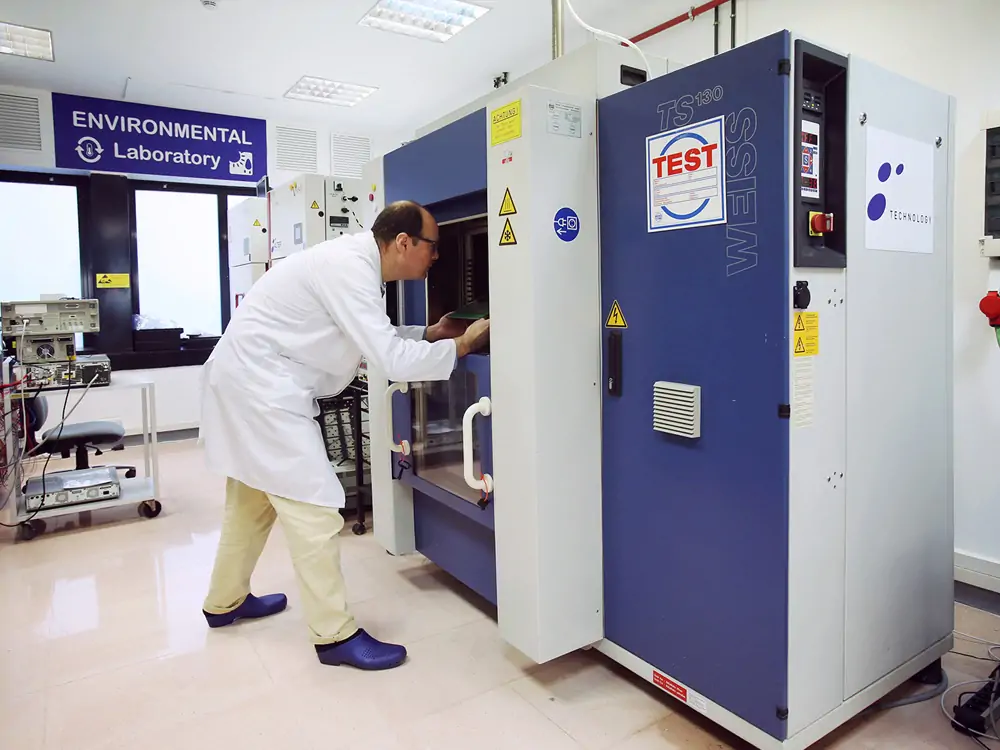In the world of product reliability testing, the Highly Accelerated Temperature and Humidity Stress Test, commonly known as the HAST Test, stands as a crucial evaluation method. This rigorous examination helps ensure the resilience and dependability of various components, especially those utilized in sensitive industries like electronics, automotive, aerospace, and defense. The Highly Accelerated Temperature and Humidity Stress Test is a rigorous evaluation method employed to assess the reliability and durability of electronic components. It involves exposing the components to elevated levels of temperature and humidity within specialized environmental chambers. This accelerated testing methodology aids in simulating real-world conditions and helps identify potential weaknesses in the materials.
Purpose of HAST Testing

The primary purpose of the HAST test is to expedite the aging process of electronic components, enabling manufacturers to predict their lifespan accurately. By subjecting materials to harsh environmental conditions, engineers can uncover vulnerabilities that may not be apparent under normal operating circumstances. This invaluable information allows for design improvements and enhances overall product reliability.
Core Principles of the HAST Test
There are two major principles of product reliability testing:
Temperature and Humidity Stress Factors
The core principle of this testing lies in the application of elevated temperature and humidity levels. These stress factors are carefully controlled to mimic the extreme conditions that electronic components may encounter during their operational life. By subjecting the materials to such harsh environments, engineers can observe how they respond and identify potential points of failure.
Accelerated Testing Methodology
HAST testing employs an accelerated testing methodology to compress the aging process. By exposing the components to heightened stress factors, manufacturers can obtain results in a fraction of the time it would take under normal conditions. This time-saving approach is invaluable in today’s competitive market, where speed to market is a crucial factor.

Process of Conducting HAST Process
1.Preparing Test Samples
Selection of components/materials: The selection of components and materials is a critical step in the process. Engineers must choose representative samples that accurately reflect the materials used in the final product. This ensures that the test results apply to the entire batch of components.
Sample size considerations: Determining the appropriate sample size is essential for obtaining statistically significant results. Engineers must strike a balance between testing a sufficient number of samples to draw meaningful conclusions and minimizing resource consumption.
2.Setting Test Parameters
Temperature range: The temperature range is carefully selected to create a controlled environment that replicates extreme conditions. This range is tailored to the specific requirements of the electronic components under evaluation.
Humidity levels: Humidity levels are adjusted to mimic the moisture levels that components may encounter during their operational life. This controlled environment helps reveal any susceptibility to moisture-related failures.
3.Test Equipment and Chambers
Environmental chambers play a pivotal role in conducting a successful HAST Test. These specialized chambers provide a controlled environment where temperature and humidity levels can be precisely regulated. These chambers are equipped with advanced monitoring and control systems to ensure the accuracy and consistency of the testing environment.

Applications of Product Reliability Testing
Electronics Industry
In the fast-paced world of electronics, reliability is paramount. This testing is widely employed to assess the durability of semiconductors, integrated circuits, and other electronic components. It helps manufacturers identify and rectify potential weaknesses before they become costly issues in real-world applications.
Automotive Industry
Automotive components are subjected to a wide range of environmental conditions, from scorching heat to cold. HAST testing is instrumental in ensuring the reliability of critical parts such as sensors, control units, and connectors. This rigorous testing process helps automotive manufacturers deliver vehicles that withstand diverse climates.
Aerospace and Defense
In the aerospace and defense industries, where precision and dependability are non-negotiable, this testing is indispensable. Avionics, communication systems, and other mission-critical components undergo rigorous evaluation to guarantee they can perform flawlessly even in the harshest environments.
Medical Device Industry
In the field of medical devices, reliability is of paramount importance. Product reliability testing is employed to evaluate electronic components used in devices like pacemakers, infusion pumps, and diagnostic equipment. Ensuring that these components can withstand harsh environmental conditions is essential for patient safety and device effectiveness.
Telecommunications
Telecommunication equipment, including routers, switches, and communication modules, must operate reliably in diverse environments. Reliability testing is utilized to assess the durability of electronic components in these devices, ensuring uninterrupted communication services even in challenging conditions.
Renewable Energy
As the demand for renewable energy sources continues to grow, the reliability of electronic components in solar panels, wind turbines, and other renewable energy systems becomes critical. It is employed to evaluate the performance of components exposed to the harsh environmental conditions encountered in renewable energy applications.
Consumer Electronics
In the fast-paced world of consumer electronics, products like smartphones, tablets, and wearable devices are expected to function flawlessly in various environments. The testing is utilized to assess the durability of electronic components, ensuring that consumer devices meet high-reliability standards.
Energy and Power Systems
In power generation, distribution, and transmission systems, electronic components play a vital role. HAST Testing is used to evaluate the reliability of components in power converters, inverters, and control systems, ensuring a stable and uninterrupted energy supply.
Marine and Offshore Industry
In marine and offshore industries, electronic components are used in navigation systems, communication equipment, and control systems. It is crucial to evaluate the reliability of these components, given the harsh and corrosive environments they may encounter.
By encompassing such a diverse range of industries, this testing demonstrates its versatility and importance in ensuring the reliability and durability of electronic components across various applications.
Advantages and Limitations of HAST Testing
Advantages
- It accelerates the product development cycle by quickly identifying potential issues. This leads to faster iterations and ultimately speeds up the time it takes to bring a product to market.
- By exposing components to extreme conditions early on, manufacturers can make design adjustments that significantly extend the lifespan of the final product.
- It allows for tailored environmental conditions, ensuring that components are evaluated under scenarios that closely mirror their intended applications.
- In industries with strict quality and safety regulations, such as aerospace and medical devices, this testing provides critical data for compliance with industry standards.
- The data generated can be used to create reliability models, enabling manufacturers to make informed predictions about the performance of their products over time.
Limitations
- While this test provides valuable insights, it may not perfectly replicate the complex and varied conditions that components encounter in real-world applications.
- Some materials may react differently to the stress factors applied in this testing. Engineers must consider the compatibility of materials with the testing process.
- Setting up and conducting HAST tests can be resource-intensive, particularly for smaller manufacturers. Balancing the benefits against the costs is a critical consideration.
- The accelerated nature generates a significant amount of waste, particularly in terms of energy consumption. Manufacturers should explore sustainable practices to mitigate the environmental impact.
- Extremely small or delicate components may not lend themselves well to HAST testing, as the stress factors may cause unintended damage.
Manufacturers need to weigh these advantages and limitations carefully and integrate HAST testing into their overall product development and quality assurance strategies judiciously. This balanced approach ensures that the benefits of this testing are maximized while recognizing its inherent constraints.
Conclusion
The Highly Accelerated Temperature and Humidity Stress Test plays a pivotal role in ensuring the reliability of products across various industries. By subjecting components to extreme conditions, manufacturers can identify and address potential weaknesses, ultimately delivering products that meet the highest standards of quality and dependability. In an ever-evolving technological landscape, the insights gained from HAST testing are invaluable, solidifying its position as an indispensable tool in the pursuit of product reliability.
For more environmental test chamber, Please visit: https://chiuventionclimatechamber.com
For more environmental test simulation programmes,environmental testing knowledge, instrument knowledge, and environmental testing laboratory knowledge, please contact us: [email protected]